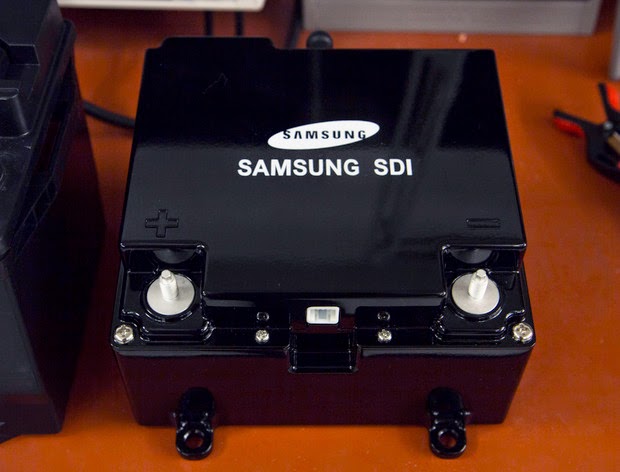One of the negative impacts of regular gasoline powered cars is the lead-acid battery that drives the starter motor, and also helps to run the 12 volt system. Lead acid battery production has a negative impact because Lead is obviously one of the horrid chemicals. While lead acid batteries are easily recyclable, that isn’t always done in a clean way. Further, because lead acid batteries have a low energy-weight ratio, vehicles are heavier than they need be, and less efficient. Ford and Samsung SDI announced today a partnership that could address all that, and down the road eliminate the need for lead acid batteries in all vehicles, replacing them with advanced lithium batteries.
By the way, today’s electric cars have lead acid batteries to help run the 12 volt system.
The announcement today is the result of 10 years of research. The current implementation is a hybrid battery system comprising a lithium-ion battery pack, and a 12 volt lead acid battery. In other words, they haven’t yet eliminated that battery technology, so that’s a ways down the road.
The target is “non-hybrid vehicles,” and the auto-start-stop technology which could make for huge reductions in gasoline consumption. While we want all cars to be proper electric vehicles, it may be a pragmatic step to develop a system that could be applied at low cost, using advanced battery systems, and which drastically reduces gasoline consumption. That’s what auto-start-stop is, so far as I understand it.
“We are currently expanding our Auto Start-Stop technology across 70 percent of our lineup, and this dual-battery system has the potential to bring even more levels of hybridization to our vehicles for greater energy savings across the board,” said Ted Miller, senior manager, Energy Storage Strategy and Research, Ford Motor Company. “Although still in research, this type of battery could provide a near-term solution for greater reduction of carbon dioxide.”
Note – 70% of Ford’s vehicle lineup is quite a lot of vehicles.
The video provided by Ford gives a few further hints of what they mean to do with this technology.
First, Ford has a general lightweighting strategy, to build vehicles using lighter materials providing the same functionality. For example, you can buy an F150 with an aluminum body IIRC. Lighter weight vehicles require less energy to move, therefore require less fuel, therefore are more fuel efficient, therefore make smaller environmental impact. In theory.
Replacing lead-acid batteries with lithium-ion batteries would, in theory, give the same kind of benefit. Lighter weight for the same performance. But lithium-ion batteries in a gasoline car have to produce enough power to crank the engine. That is, Ford describes in this video three functions: starting the engine, regenerative braking, low temperature performance, and powering the accessory system (12 volts) when the engine is off.
In auto-start-stop vehicles, the engine is stopped and restarted frequently. In the video the Samsung dude is saying that lithium batteries perform better (better charge/discharge behavior) than lead-acid. But they’re not yet comfortable with using just a lithium pack with no lead-acid battery.
The press release also names off some of Ford’s legacy in battery research. A little known fact, that is mentioned here, is that a hundred years ago Henry Ford and Thomas Edison developed an idea for mass produced electric cars, coupled with home scale wind turbines and home scale electricity storage systems. The two worked on developing nickel-iron batteries, and did some testing, but the tests didn’t work out very well. The project really collapsed when Edison’s factory complex mysteriously caught fire and burned.
Anyway… more recently, Ford has been working with several energy storage companies on research projects, not all of which are energy storage systems inside vehicles. Some are grid scale energy storage systems. Some of the work occurs under the umbrella of the United States Advanced Battery Consortium. It’s thought that in the long term, electric vehicles will be routinely connected to charging stations that can then treat the sum of all connected electric cars as a giant grid scale energy storage system.
UPDATE: I’ve been told that some areas have laws requiring that all cars have “wet cell batteries”. One can understand the legislators were probably interested in ensuring reliability – but that technology developments might make such requirements antiquated. Laws will have to change, and fortunately Ford probably has enough lawyers to do so.
It’s a promising idea, don’t you think? Let me know what you think in the comments below. Would we prefer Ford worked on vehicles that can be plugged in?
- Highway design could decrease death and injury risk, if “we” chose smarter designs - March 28, 2015
- GM really did trademark “range anxiety”, only later to abandon that mark - March 25, 2015
- US Government releases new regulations on hydraulic fracturing, that some call “toothless” - March 20, 2015
- Tesla Motors magic pill to solve range anxiety doesn’t quite instill range confidence - March 19, 2015
- Update on Galena IL oil train – 21 cars involved, which were the supposedly safer CP1232 design - March 7, 2015
- Another oil bomb train – why are they shipping crude oil by train? – Symptoms of fossil fuel addiction - March 6, 2015
- Chevron relinquishes fracking in Romania, as part of broader pull-out from Eastern European fracking operations - February 22, 2015
- Answer anti- electric car articles with truth and pride – truth outshines all distortions - February 19, 2015
- Apple taking big risk on developing a car? Please, Apple, don’t go there! - February 16, 2015
- Toyota, Nissan, Honda working on Japanese fuel cell infrastructure for Japanese government - February 12, 2015












